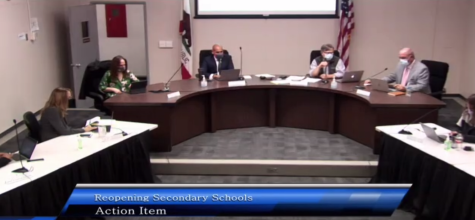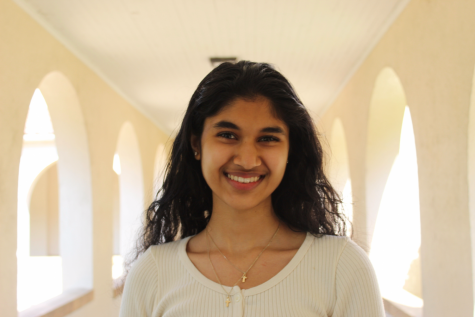Petitioners against reopening likely to achieve goal, despite board plans
November 20, 2020

After widespread community backlash, including an open letter from district teachers and petitions exhibiting dozens of student signatures, and after the surprise return of the Santa Clara County to Purple Tier of the state’s Covid-19 response system, the Palo Alto Board of Education may not see its 10-day-old hybrid return plan realized in January.
Jennifer Dibrienza, a school board member, said reopening will ultimately be based on county health guidelines.
“If the county gives us guidance that it looks like we will be able to open in January in person, then I believe the board will come together to make some decisions,” Dibrienza said. “If the county tells us there is no way we can open in January, then there is no decision for us to make.”
And that’s exactly what the Santa Clara County is positioned to do, according to a statement today released by Superintendent Don Austin.
“It is highly unlikely we can navigate a return for our high school students by Jan. 7,” Austin said. “Due to the enormous hurdle of scheduling … we may be headed for a second semester in distance learning.”
County directives are not the only forces pushing against the reopening plan. The open letter from Gunn High School teachers — later endorsed by a number of Palo Alto High School teachers — cited a list of concerns about the district’s hybrid reopening plan, which is scheduled, now tenuously, to go into effect Jan. 7. Student petitions against the hybrid plan are circulating as well, further emphasizing the misalignment between the district and significant portions of the student and faculty community.
The Gunn letter pinpoints teacher and community worries with the reopening plan. It begins by pointing out multiple statements made at the Dec. 10 board meeting that the teachers said were inaccurate or misleading, mainly to do with teacher consultations and the effects of the plan on scheduling and class sizes. Later, the letter recognizes the detriments of disrupting schedules mid-year, potential inequity due to increased class sizes, health risks in in-person school, and further concerns over the logistics of the hybrid proposal.
School board member Kenneth Dauber told The Paly Voice, speaking before the county slipped into the Purple Tier, that the board would likely not reconsider the decision to support the January the reopening plan in spite of the immense outcry from the student body and teachers, as there is no “new information” to change the decision.
“We [the board] want an opportunity for students to be in school to the extent that we possibly can,” Dauber said. “Even though the district has done really, really well, and teachers have done really well in providing distance learning opportunities … being in school is better. And for some students, it’s really critical that they be in school, so we are looking for safe opportunities to provide students who really need it with an option to be in school.”
Board president Todd Collins wrote to The Paly Voice after the letter’s publishing that the board “doesn’t have any special meetings scheduled at this time” to reopen discussions over the plan.
Before the county’s new limitations sent plans up in the air, many teachers voiced their thoughts at last week’s board meeting, to no avail. Paly English teacher Lucy Filppu told the Voice she feels the hybrid plan is “a rushed option that will have far more unexpected limitations and implications than we can anticipate.”
The Palo Alto Educators Association had proposed a plan that consisted of an in-person option on Mondays with distance learning continued for the remainder of the week. This plan was not discussed at the board meeting — Superintendent Don Austin said in an interview with The Paly Voice that it did not align with the board’s goals for reopening education.
Dauber agreed.
“Speaking personally, I really was looking for giving students a real option for a meaningful presence on campus, which I think is more than a day a week,” Dauber said.
Dauber noted that the boards’ goals to “get back as many students as safe” onto campus and to “produce a little disruption as we can” may inherently conflict. Pending the outcome of incoming data on reopening selections from the students and families, Paly may assign modified schedules for second semester or maintain the current distance-learning schedules.
According to Paly Advanced Placement Psychology and sociology teacher Melinda Mattes, the shuffling of teachers and courses is her “number one concern” as it would damage valuable student and teacher relationships built over the past semester — relationships vital to the learning experience. Online-learning features such as Zoom’s private chat have been a surprising silver-lining as well in increasing student engagement, Mattes told the Voice.
Filppu also held a contrasting view to the board on the proposal’s effect on district education goals.
“This reopening plan runs counter to our SPSA [School Plan for Student Achievement], LCAP [Local Control and Accountability Plan] and WASC [Western Association of Schools and Colleges] goals pertaining to high-quality teaching and learning as it disrupts teacher assignments for all students regardless of the model a student chooses,” Filppu said. “This also likely will make it harder to achieve our wellness goal of ensuring that each student who selects distanced learning has one trusted adult at Paly they can talk to, as those classes will be bigger.”
Paly English teacher Sarah Bartlett expressed unsettlement over what she said was the district’s lack of transparency with staff over the plan before the deciding board meeting.
“It was a shock to me and to several of my English department colleagues to hear last week that our entire department would be coming back to campus to teach in person,” Bartlett said. “On Friday [Nov. 6], I learned in a PAEA meeting that my department would be returning in person. As far as I know, none of us knew that was even being considered.”
Bartlett highlighted safety as a topic of discussion as well, for both teachers and students.
“PAEA has sent more than one letter signed by many teachers expressing concerns about teacher safety when elementary and secondary schools reopen,” Bartlett said.
Nonetheless, Dauber said the board is adamant on reopening if regulations do permit in-person learning in January.
“It would be astonishing if we got through these complicated choices without there being disagreement,” Dauber said. “The fact that the board has made, and that I’ve made, decisions that are different than what some have advocated doesn’t mean that I don’t understand the positions that people have or that I’m not listening … we’re looking at the total situation, and trying to achieve these outcomes and serve these values.”








![A protester in a chicken suit wearing a taco hat with the words “Cluck Trump” at the “No Kings” Democracy Fair in Palo Alto on Saturday. Protestor Mary Chan said she and her husband are horrified at the state of science and medicine in America. “What he [Trump] is doing by defunding scientific research is destroying our academic medical centers, and he’s [Trump] bankrupting rural medical centers,” Chan said. “We will have lasting negative impacts on American health for decades.”](https://palyvoice.com/wp-content/uploads/2025/10/11562FFE-9912-4152-BB01-582426B52ECB_1_105_c-225x300.jpeg)